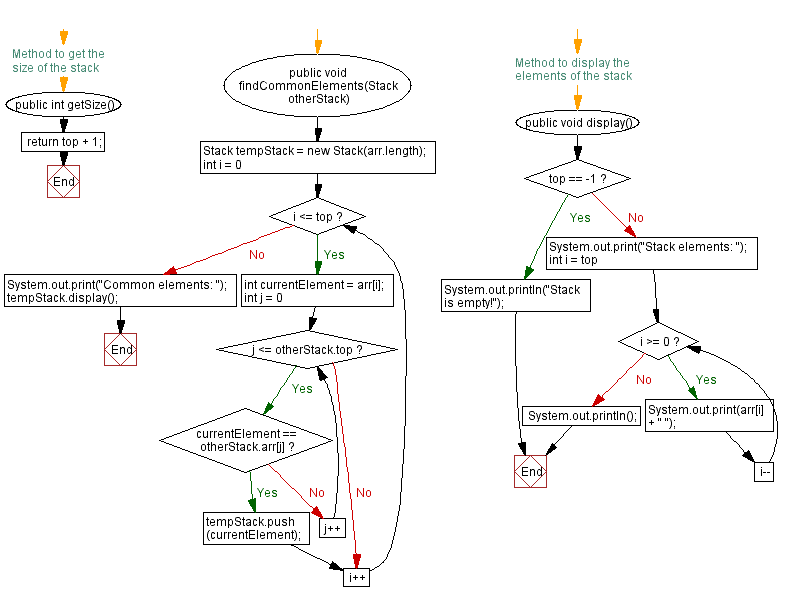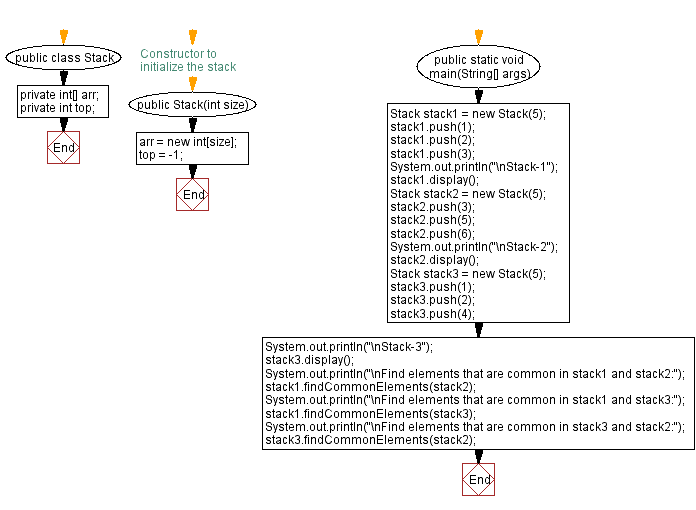Java: Find common elements between two stacks
Write a Java program that implements a stack and finds common elements between two stacks.
Sample Solution:
Java Code:
import java.util.Scanner;
public class Stack {
private int[] arr;
private int top;
// Constructor to initialize the stack
public Stack(int size) {
arr = new int[size];
top = -1;
}
// Method to push an element onto the stack
public void push(int num) {
if (top == arr.length - 1) {
System.out.println("Stack is full");
} else {
top++;
arr[top] = num;
}
}
// Method to pop an element from the stack
public int pop() {
if (top == -1) {
System.out.println("Stack Underflow");
return -1;
} else {
int poppedElement = arr[top];
top--;
return poppedElement;
}
}
// Method to get the top element of the stack
public int peek() {
if (top == -1) {
System.out.println("Stack is empty");
return -1;
} else {
return arr[top];
}
}
// Method to check if the stack is empty
public boolean isEmpty() {
return top == -1;
}
// Method to get the size of the stack
public int getSize() {
return top + 1;
}
public void findCommonElements(Stack otherStack) {
Stack tempStack = new Stack(arr.length);
for (int i = 0; i <= top; i++) {
int currentElement = arr[i];
for (int j = 0; j <= otherStack.top; j++) {
if (currentElement == otherStack.arr[j]) {
tempStack.push(currentElement);
break;
}
}
}
System.out.print("Common elements: ");
tempStack.display();
}
// Method to display the elements of the stack
public void display() {
if (top == -1) {
System.out.println("Stack is empty!");
} else {
System.out.print("Stack elements: ");
for (int i = top; i >= 0; i--) {
System.out.print(arr[i] + " ");
}
System.out.println();
}
}
public static void main(String[] args) {
Stack stack1 = new Stack(5);
stack1.push(1);
stack1.push(2);
stack1.push(3);
System.out.println("\nStack-1");
stack1.display();
Stack stack2 = new Stack(5);
stack2.push(3);
stack2.push(5);
stack2.push(6);
System.out.println("\nStack-2");
stack2.display();
Stack stack3 = new Stack(5);
stack3.push(1);
stack3.push(2);
stack3.push(4);
System.out.println("\nStack-3");
stack3.display();
System.out.println("\nFind elements that are common in stack1 and stack2:");
stack1.findCommonElements(stack2);
System.out.println("\nFind elements that are common in stack1 and stack3:");
stack1.findCommonElements(stack3);
System.out.println("\nFind elements that are common in stack3 and stack2:");
stack3.findCommonElements(stack2);
}
}
Sample Output:
Stack-1 Stack elements: 3 2 1 Stack-2 Stack elements: 6 5 3 Stack-3 Stack elements: 4 2 1 Find elements that are common in stack1 and stack2: Common elements: Stack elements: 3 Find elements that are common in stack1 and stack3: Common elements: Stack elements: 2 1 Find elements that are common in stack3 and stack2: Common elements: Stack is empty/No common elements
Flowchart:



For more Practice: Solve these Related Problems:
- Write a Java program to retrieve the common elements between two stacks using a HashSet and stream filtering.
- Write a Java program to compare two stacks and return a new stack containing only the common elements.
- Write a Java program to use recursion to extract and print the intersection of two stacks.
- Write a Java program to implement a method that finds common elements in two stacks without using extra data structures.
Live Demo:
Java Code Editor:
Improve this sample solution and post your code through Disqus
Java Stack Previous: Checks if two stacks are equal.
Java Stack Exercises Next: Stack elements in the first but not in the second.
What is the difficulty level of this exercise?
Test your Programming skills with w3resource's quiz.
